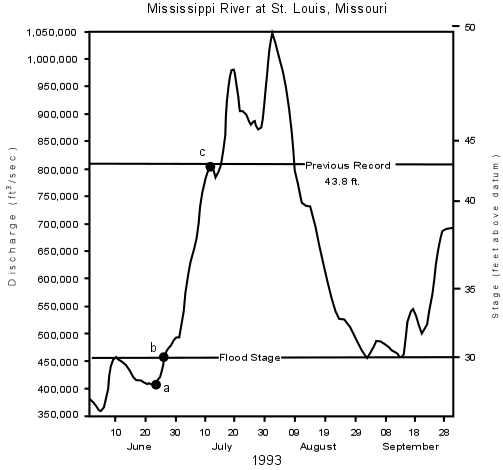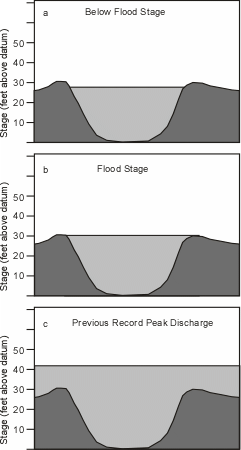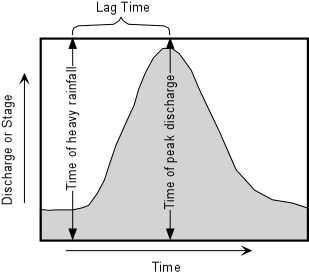
| EENS 3050 | Natural Disasters |
| Tulane University | Prof. Stephen A. Nelson |
River Flooding |
|
River Flooding Having covered the basics of stream systems we now turn our attention to the details of flooding associated with rivers and streams. Flood Stage
|
|
|
 |
Factors that Affect Flooding As discussed previously the main factors that cause flooding are heavy rainfall, sudden or heavy snow melt, and dam failure. Now that we understand something about levees and floodplains, we can add to this list the possibility of levee failure. All of these factors can suddenly increase discharge of water into streams, within streams, and out of streams. Furthermore, as we have just seen, when the discharge causes the river to rise above flood stage water runs onto the floodplain. Here we discuss the main cause of flooding, that is heavy rainfall over a short period of time. When rain falls on the surface of the Earth, some of the water is evaporated and returns to the atmosphere, some of it infiltrates the soil and moves downward into the groundwater system, and some is intercepted by depressions and vegetation. What remains on the surface of the Earth and eventually flows into streams is called runoff. In general, then: Runoff = Precipitation - Infiltration - Interception - Evaporation Evaporation tends to be the least of these quantities, particularly over
short periods of time, and thus precipitation, infiltration, and interception are the most
important variables that determine runoff and eventual discharge into streams. |
Rainfall Distribution If rainfall is heavier than normal in a particular area and infiltration, interception, and evaporation are low then runoff can be high and the likelihood of flooding will increase. Heavy rainfall can be depicted on maps that show curves of equal rainfall. Such curves are called isohyets, and the resulting maps are called isohyetal maps. |
|
|
 |
|
If large amounts of rain fall over an extended period of time over a large
region, downstream floods (also called regional floods) may occur. Lag times are usually
longer as tributary streams continually increase the discharge into larger streams.
Such floods extend over long periods of time and affect the larger streams as well
as tributary streams. The 1993 flood on the upper Mississippi River is considered a
downstream flood. Water levels rise slowly and dissipate slowly (in the case of the
1993 flood, the increase in discharge to the peak occurred over several weeks after
several weeks of intense rainfall, and it took several months for river stages to return
to normal levels). |
Infiltration
Infiltration is controlled by how readily the water can seep into the soil, be absorbed by the soil, and work its way down to the water table. Several factors determine the rate of infiltration:
|
Interception |
Levee Failures Natural levees are constructed as a result of flooding, as we saw in the discussion last
lecture. But, natural levees tend to be relatively low and do not offer much
protection from large discharge because they can easily be overtopped. Human made
levees, such as we see on the Mississippi River along much of its length, are much higher
and are constructed to prevent flooding from high discharges on the River. Most
levees are constructed of piles of dirt (rock and soil) with a concrete cover on the river
side of the levee. Such levees often give a false sense of security for those living
on the floodplain the levee was built to protect, because failure of such levees can lead
to flooding, either because discharge can become great enough to overtop the levees or the
levees can become weakened and fail. Levees can fail for three main reasons. |
Dam Failures
|
Video The last 50 minutes of this lecture will involve the showing of a video entitled "Flood", about the 1993 Mississippi River Flood that affected over 40,000 km2 of the Midwestern states of North Dakota, South Dakota, Minnesota, Wisconsin, Nebraska, Iowa, Illinois, Kansas, and Missouri. Up to 80% of the final exam will be on this video. |
Examples of questions on this material that could be asked on an exam
Return to EENS 3050 Homepage |